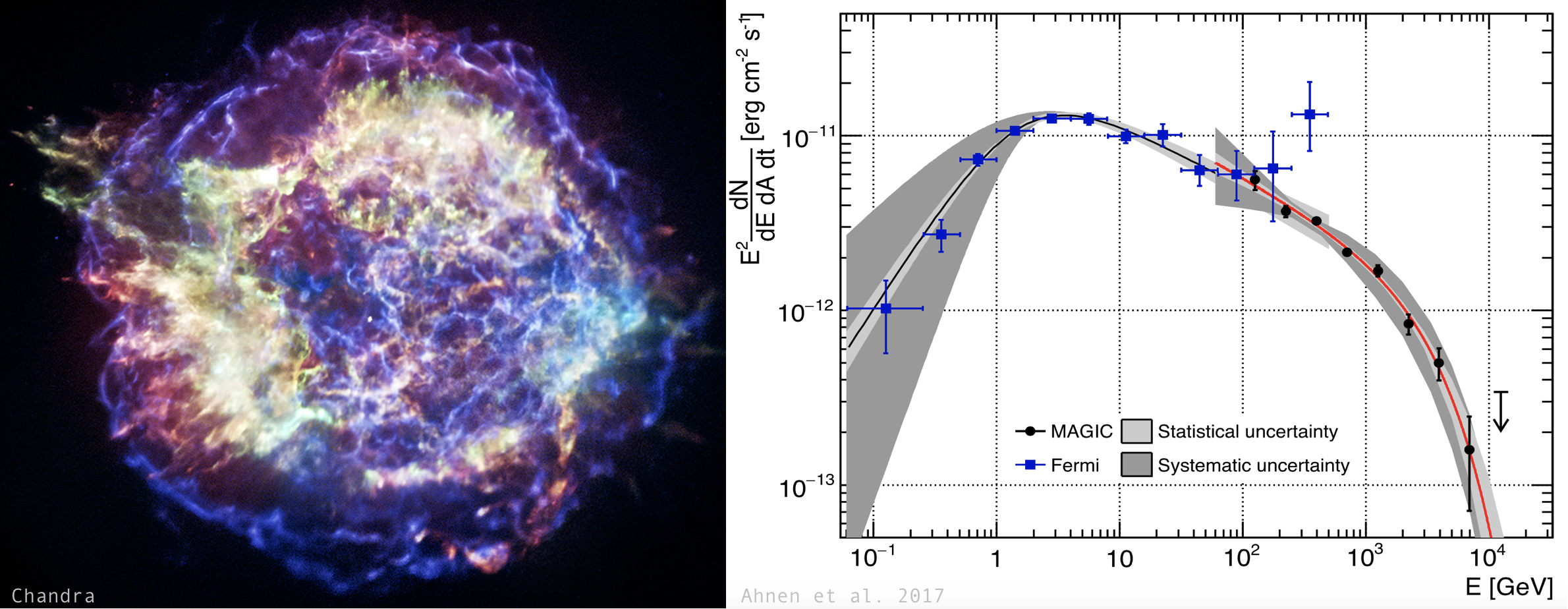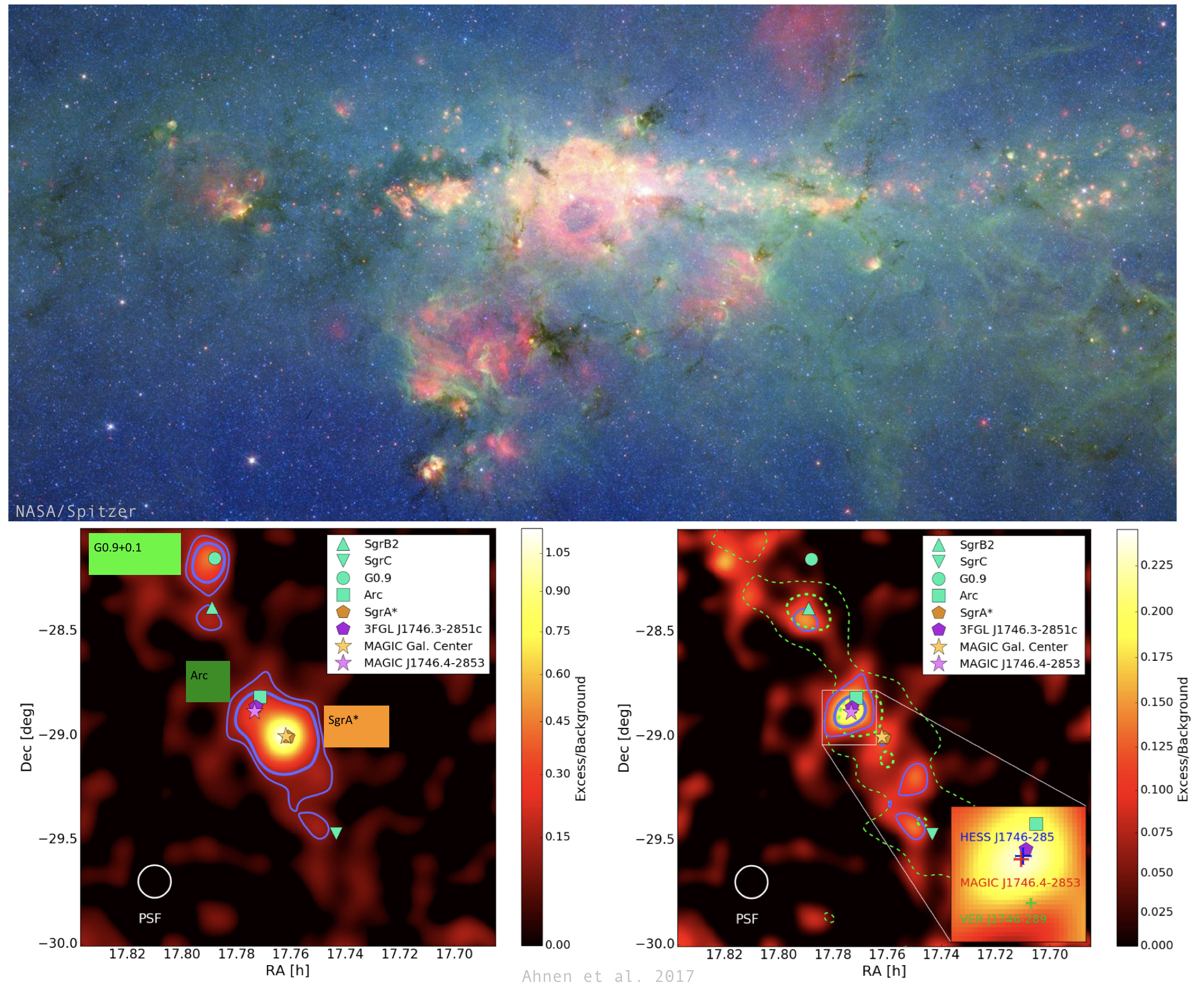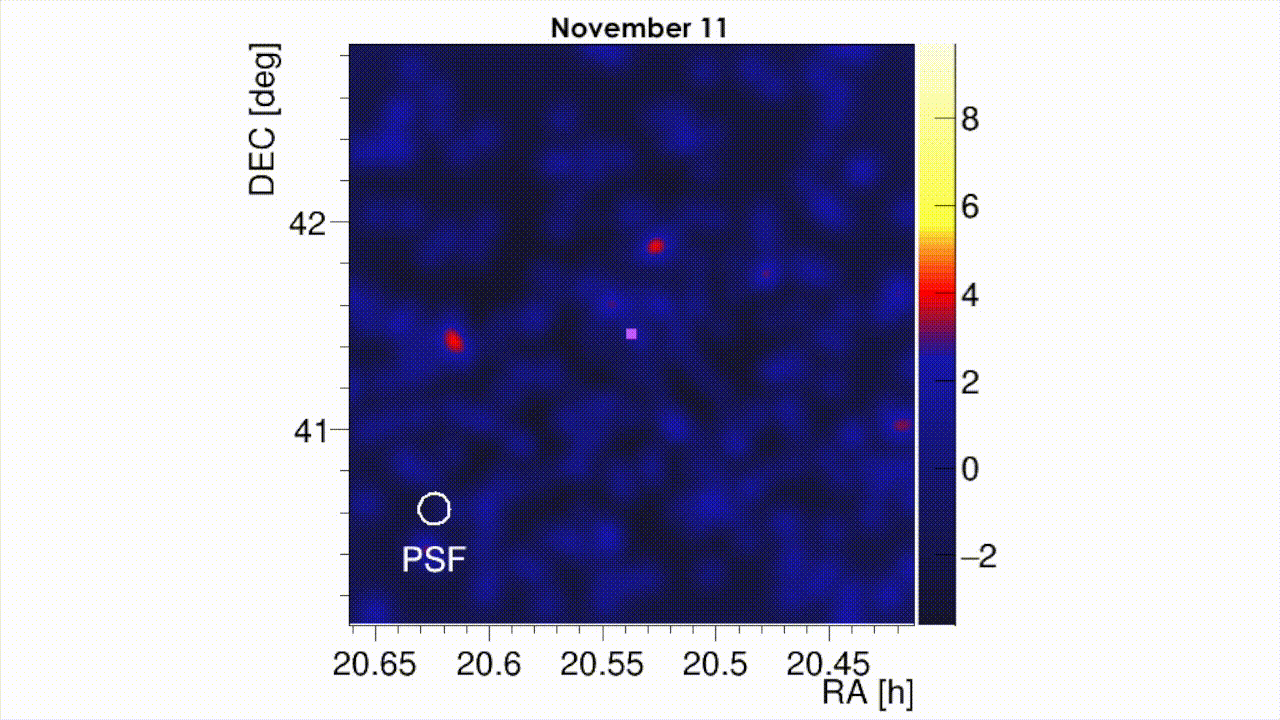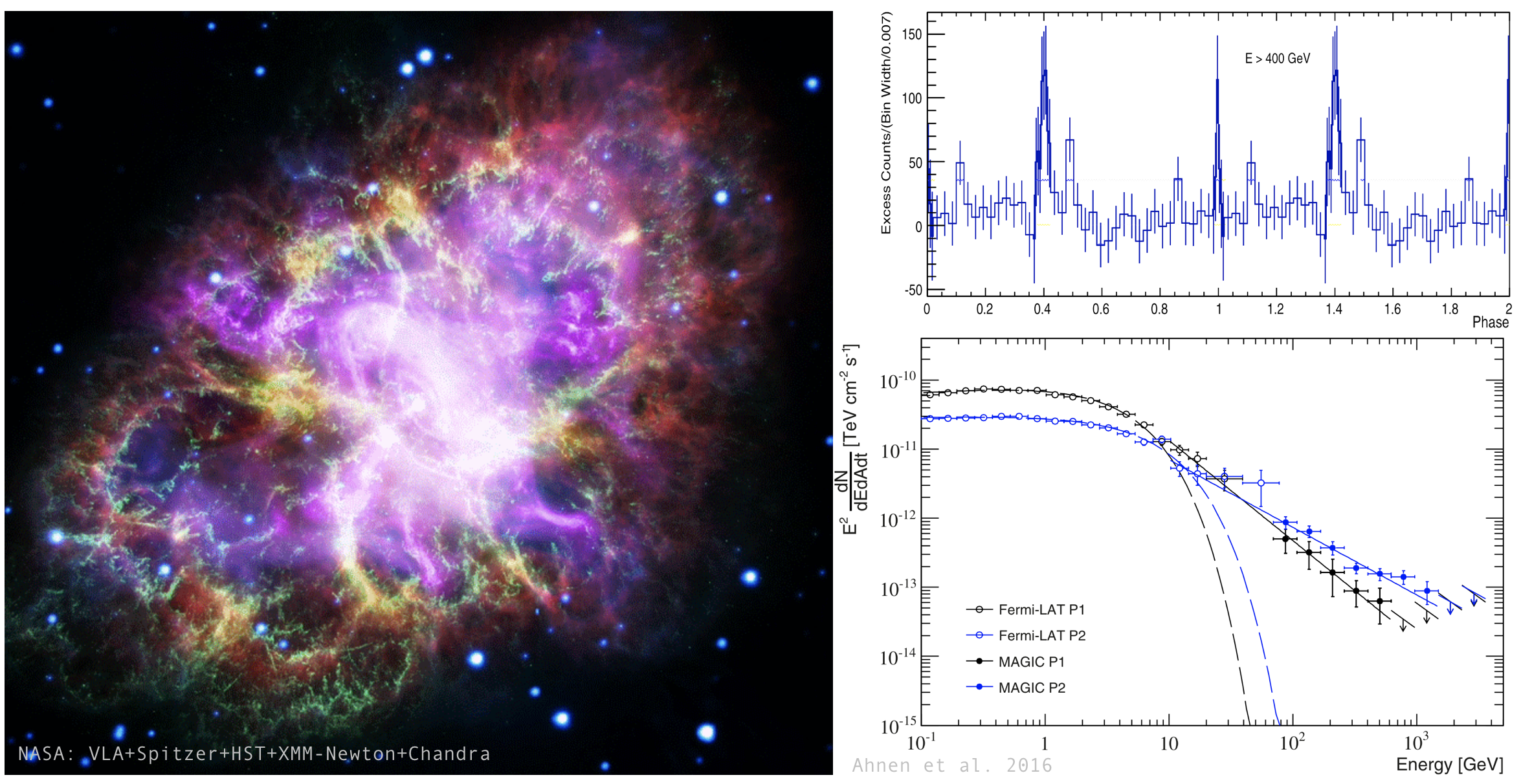MAGIC
Skip navigation and go to main content
- Home
- General Information
- Science with MAGIC
- MAGIC members
- Maintenance
Physics goals » Galactic
Supernova remnants (SNRs)
Supernova remnants (SNRs) are clouds of debris which are left when a massive star has exploded in a supernova, after consuming all its fuel. They are thought to be the site of production and acceleration of galactic cosmic rays (CRs), which are cosmic particles that have energies up to 3 PeV (identified as the “knee” feature in the CR spectrum). If that is the case, CRs would be accelerated via diffusive shock acceleration and, consequently, will emit gamma rays. To test this hypothesis precise measurements of the gamma-ray spectra of young SNRs at TeV energies are needed.
Several SNRs have been observed by MAGIC along the years: IC443
(Albert et al. 2007), W51C (Aleksić et al. 2012), W44 (Gozzini et al. 2016), …
However, one of the best candidates to be a PeVatron (that is a CR accelerator) is
Cassiopea A (Cas A), a young SNR (only 330 yrs old!) which has been largely
studied in radio and X-ray bands. MAGIC observed it for 160 hours between 2014
and 2016 and measured the Spectral Energy Distribution (SED) up to 8 TeV
(Ahnen et al. 2017). The SED shows an exponential cut-off at an energy of 3.5 TeV
and its multiwavelength emission can not explained with a single population of
electrons nor protons. However, protons are likely to dominate the TeV emission,
meaning that Cas A is most likely accelerating CRs, although to a rather low
energy of a few TeV. MAGIC results imply that Cas A SNR is not a PeVatron at
present time, since it falls short of the energies of the knee of the CR spectrum.

Chandra image of CasA (left) and its VHE spectra from MAGIC (right)
Galactic Center
The center of the Milky Way host a supermassive black hole (SMBH), which accretes mass from the surroundings. This SMBH is identified with the point-like radio source SgrA*. The central region of our Galaxy (the so-called Central Molecular Zone, CMZ), is densely populated with a large variety of astrophysical objects: SNRs, large molecular clouds (MCs), star-forming regions (SFRs), etc. Extreme particle acceleration processes take place in this region, hence implying subsequent gamma-ray emission. The Galactic Center is a bright region throughout the electromagnetic spectrum.
MAGIC has been monitoring the Galactic Center (GC) since 2005 (Albert et al.
2005), when it was first detected by a single MAGIC telescope. Since then, and
with the improved sensitivity after the construction of MAGIC-II, MAGIC has
deepened into this region. During 2012-2015, the MAGIC telescopes monitored
the fly-by passage of the large G2 gas cloud, which was expected to get disrupted
by the central SMBH. However, no enhancement of the central emission was
detected at any wavelength, either at VHE gamma rays (Ahnen et al. 2017).
Since then, MAGIC has been looking at the GC to fully describe the region at
VHE, detecting several sources of gamma-rays and studying the cosmic-ray
contribution.

Image of the Galactic Centre taken with Spitzer (top) and MAGIC (bottom)
Binaries
Stars are normally found in couples in the Universe. Some stars have been found to be orbiting either a neutron star or a black hole, which are the products of stellar evolution and death. Only 8 of these binary systems have been found to emit the bulk of their non-thermal emission within the gamma-ray domain: the so-called gamma-ray binaries. All of these gamma-ray binaries are composed of a massive star, but we do not know what the nature of the compact object is for most of them. The nature of the compact object (either neutron star or black hole) has implications in the scenario to explain the VHE gamma-ray emission: either a pulsar wind scenario, where particles are accelerated within the shock of the neutron star/stellar wind, or a microquasar scenario, where stellar mass is accreted onto the compact object. MAGIC has been searching to unveil the nature of gamma-ray binaries and add new components to this reduce family for more than a decade. MAGIC first discovered TeV emission from LS I+61º303 (Albert et al. Science, 2016) and performed many observational campaigns, first detecting the source in a low state (Aleksić et al. 2012) and discovering a long-term variability in the VHE domain (Ahnen et al. 2015). MAGIC also detected emission from the binary HESS J0632 during an X-ray outburst of the source (Aleksić et al. 2012). Recently, MAGIC (together with VERITAS) discovered the unique system PSR J2032+4127/MT91 213 at TeV energies, during the periastron passage, which takes place once every 50 years (Aberskaya et al. 2018).
MAGIC has led many campaigns to search for VHE emission from massive
microquasars as MWC 656, the only Be star with a BH companion (Aleksić et al.
2015), Cygnus X-1 (Ahnen et al. 2017) or SS433 (Ahnen et al. 2017), as well
as search for TeV from low-mass X-ray binaries (LMXBs) as GRS 1915+105
(Saito et al. 2009), Sco X-1 (Aleksić et al.2011) or V404 Cygni (Ahnen et al.
2017). Up to know, no confirmed microquasar has been detected and MAGIC
keeps hunting for them!

Image of the enhanced emission from PSR J2032 during periastron passage.
Pulsars and pulsar-wind nebulae (PWN)
A pulsar is a highly-magnetized rapidly rotating neutron star, which display pulsating beamed emission (acting like a “lighthouse”). The spectrum of pulsars at a few GeV normally show a cut-off, as seen with Fermi-LAT. Gamma rays originate due to fast rotation of the strong magnetic field, however the mechanism acting in their pulsed emission is still not firmly known. By measuring the high-end region of a pulsar’s spectrum we might be able to shed light on this question.
These pulsars might be found inside a nebula, the shell of a SNR and the pulsar will power the nebula by the winds generated in its rotation. This system is called pulsar-wind nebula (PWN) and can also be detected at TeV energies. Up to know, only two pulsars have been confirmed to be detected at TeV: the Crab Nebula pulsar and Vela pulsar. On the contrary, more than 33 PWN have been detected at VHE.
Crab is the only system in which both the pulsar and the nebula are detected at
VHE, and actually, the Crab Nebula is considered the standard candle in VHE.
The Crab pulsar was first discovered at VHE by MAGIC, by detecting pulsations
at 25 GeV (Aliu et al., Science 2008), ruling out the polar cap model. The
subsequent detections up to 100 GeV (Aleksić et al. 2011) and 400 GeV
((Aleksić et al. 2012) shown the existence of a hard component and excluding
the existence of a cut-off in the spectrum. The discovery of a bridge emission
above 50 GeV between the two main pulses (Aleksić et al. 2014) was challenging,
since it could not be explained with existing theories. The latest MAGIC results
discovered pulsed emission extending up to 1.5 TeV (Ansoldi et al. 2016).
Current models can not fully explain the presence of TeV pulsations.

Chandra image of CasA (left) and its VHE spectra from MAGIC and Fermi (right)
Other possible gamma-ray emitters
Black widows: a black widow is a binary system composed of a millisecond pulsar (MPS: a pulsar with a rotational period of 1-10 msec) and a very low mass companion star, which is being evaporated by the high energy being released by the MSP. The discovery of TeV emission from a binary containing a MSP will put new constraints on the acceleration and radiation processes of energetic particles in the vicinity of pulsars. MAGIC has searched for VHE emission in the black widow pulsar B1957+20 (Ahnen et al. 2017), but no emission was detected.
Globular clusters are large groups of stars, which are bounded gravitationally in an spherical way. These clusters are normally located in the halos of galaxies and they host old stars and MSPs (a typical massive globular cluster contains around 100 MSPs). Gamma rays are expected to be produced by accelerated leptons scattering off photons of the microwave back-ground radiation or the thermal emission of an extremely dense cluster of solar-mass stars inside the cluster. MAGIC observed the globular cluster M31, which has a mass of mass of 6x10^5 solar masses and contains at least 5 MSPs. No VHE gamma-rays were detected (Anderhub et al. 2009)
Magnetars are neutron stars which have extremely powerful magnetic fields. Their soft X-ray and gamma-ray emission is thought to be powered by the strong magnetic field. Some models predict gamma rays from this kind of sources, although none has been detected at energies higher than few MeVs. A magnetar-like event (short gamma-ray burst) was detected from the binary LS I +61º 303 (Torres et al. 2011), although no strong confirmation can be set.
Star-forming regions are dense concentrations of interstellar gas at low temperatures (10-20 K). The collapse of the denser parts will provoke the fragmentation into smaller clumps that will trigger star formation. In these regions, gamma rays could be produced due to several mechanisms: due to strong stellar winds of individual stars or binaries inside the SFR, due to magnetic turbulences or diffusive shock acceleration (if a molecular cloud is present). Some have been detected within the gamma ray domain, like the Cygnus Cocoon.